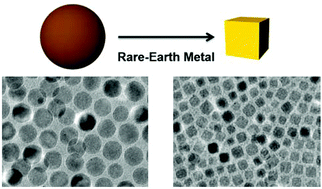Shape-controlled syntheses of metal oxide nanoparticles by the introduction of rare-earth metals†
Abstract
Here, we report the size- and shape-controlled synthesis of metal oxide nanoparticles through the introduction of rare-earth metals. The addition of gadolinium oleate in the synthesis of iron oxide nanoparticles induced sphere-to-cube shape changes of nanoparticles and generated iron oxide nanocubes coated with gadolinium. Based on experimental investigations and density functional theory (DFT) calculations, we attribute the shape change to the facet-selective binding of undecomposed gadolinium oleates. While many previous studies on the shape-controlled syntheses of nanoparticles rely on the stabilization of specific crystal facets by anionic surfactants or their decomposition products, this study shows that the interaction between growing transition metal oxide nanoparticles and rare-earth metal complexes can be used as a robust new mechanism for shape-controlled syntheses. Indeed, we demonstrated that this approach was applicable to other transition metal oxide nanoparticles (i.e., manganese oxide and manganese ferrite) and rare earth metals (i.e., gadolinium, europium, and cerium). This study also demonstrates that the nature of metal–ligand bonding can play an important role in the shape control of nanoparticles.

- This article is part of the themed collection: Celebrating Excellence in Research: Women of Materials Science


 Please wait while we load your content...
Please wait while we load your content...